100 Years, 100 Stories – March
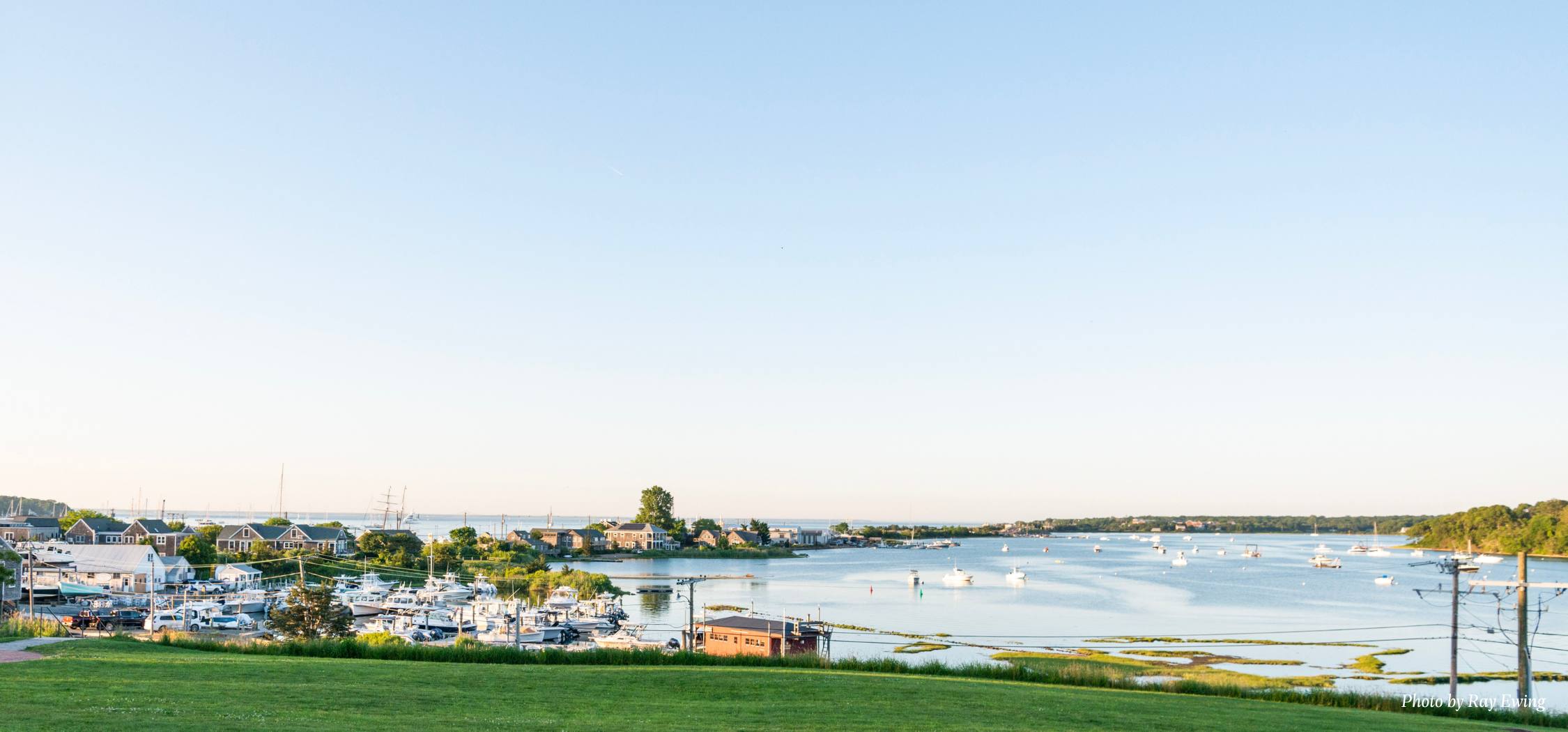
100 Years, 100 Stories
March: Getting Here
Inhabitants of Martha’s Vineyard have been crossing the open water dividing it from the mainland for seven thousand years: in dugout mishoons, in wind-driven sloops and catboats, and (for two centuries) in ships driven by steam and diesel engines. The introduction of modern car ferries and scheduled air service after 1945 made travel to the Vineyard easier, but not effortless. Wind and weather still cut off service from time to time, reminding us that, despite all our technological advances, the Vineyard is still an island.
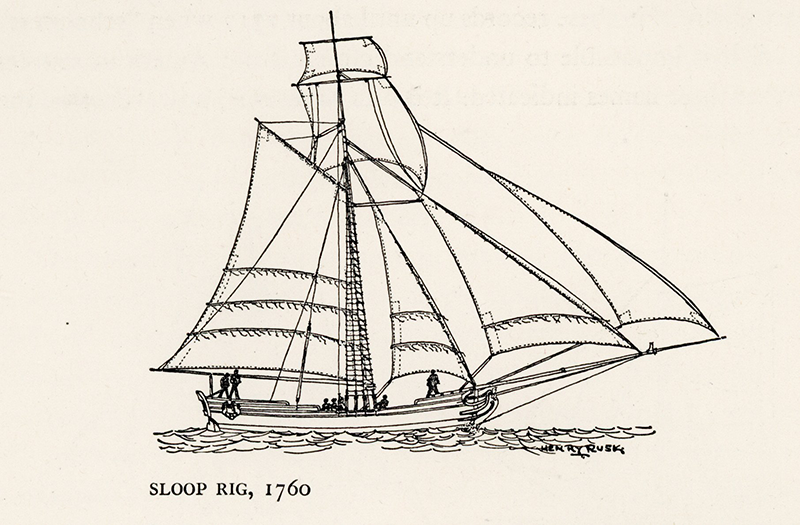
1. A sloop: the backbone of Island ferry services before steam power
Title: Sloop (from Howard I. Chappelle, The History of American Sailing Ships)
Artist: Henry Rusk
Date: 1935
Reference: 656 C8.1
The first human inhabitants of what became known as Martha’s Vineyard, arrived on foot. The Island was not yet an island — the edge of the ocean lay 50 miles south of what is now South Beach — and Vineyard and Nantucket Sounds were dry channels. Over time the waters rose, creating an island. Boats whose owners would transport people and goods for a fee quickly followed.
The first regular ferry service to Martha’s Vineyard was established in the early 1700s by Abraham Chase, probably using a sloop like this one. Sloops, seaworthy enough for open water but small enough to be handled by a crew of one or two, were mainstays of the short-haul trade in eighteenth-century New England.
Chase shuttled his vessel between the sheltered harbors at Falmouth and his hometown of Holmes Hole (now Vineyard Haven). On the Holmes Hole end of the trip, Chase sailed up Bass Creek — a 7-foot-deep channel that ran where Water Street and Lagoon Pond Road are today — to a pier at the edge of what is now the Five Corners intersection. After the last trip of the day, he would continue up Bass Creek into the Lagoon, and anchor for the night in the lee of what is still called Ferryboat Island.
2. Monohansett, the first reliable steam ferry to serve Martha’s Vineyard
Title: Steamer Monohansett
Artist: J. P. Winegar
Date: 1882
Reference: 1955.003.216

The first Cape-and-Islands steamboat service was inaugurated by the Eagle in 1818, and more than a dozen paddlewheel steamers ran to Martha’s Vineyard and Nantucket over the next four decades, most for only a year or two. The early steamers suffered from frequent mechanical breakdowns, occasional fires, and underpowered engines that often left them struggling to make headway against the wind, waves, and current.
Island Home, designed specifically for the Nantucket service and launched in 1855, was the first Cape-and-Islands steamer powerful and reliable enough to keep to a published schedule in anything but the worst weather. The Monohansett, launched in 1862, brought the same reliability to the Martha’s Vineyard run, and quickly became Vineyarders’ favorite steamer. Every steamer built for the Cape-and-Islands service for the next forty years was modeled on her design.
Designed primarily to carry passengers and their luggage, Monohansett’s capacity was immense. She carried 1,400 worshippers to the Island for the closing Sunday of the Wesleyan Grove Camp Meeting in August 1863, and 1,800 back to the Cape that evening. After serving the Vineyard for forty years, she was sold in 1902 to make way for the new steamer Uncatena — the last paddlewheel steamer built for Island service.
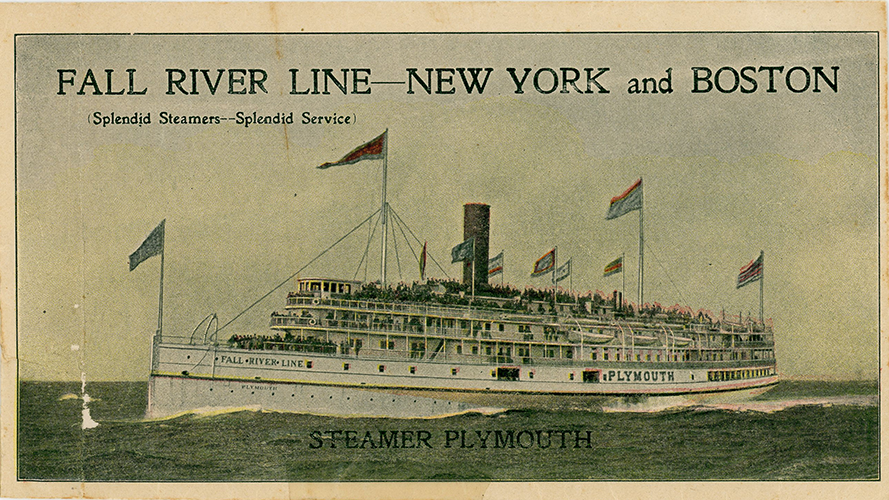
3. “Night boats” connected New York and Martha’s Vineyard
Title: Fall River Line – New York and Boston
Date: c.1900
Reference: RU 131
The Fall River Line operated a fleet of lavishly appointed steamers that plied the coastal waters of southern New England, connecting New York, Boston, and points between. The line’s “night boat” service, carried on by steamers like the Plymouth, advertised here departed from the piers of lower Manhattan at dinnertime for an overnight trip up Long Island Sound to Fall River, where passengers could connect with trains to Boston or smaller steamers that ran from New Bedford to Martha’s Vineyard and Nantucket.
The Fall River Line did not serve the Islands directly but–along with the Old Colony and New York, New Haven, and Hartford railroads, it formed part of a transportation network that made the Vineyard accessible to residents of every major city in southern New England. From the end of the Civil War to the beginning of World War II, summer vacations on Martha’s Vineyard depended on travel by train and steamer and (for most vacationers) took place in resort hotels, guest houses, and second homes built within easy reach of the steamer wharves. Only with the post-1945 development of highways and “roll-on/roll-off” ferries like the Islander (1950) did car-based tourism become the norm.
4. This 1934 travel poster promoted the Vineyard as a playground of the rich and stylish
Title: Enchanted Isle
Artist: John Held, Jr.
Date: 1934
Reference: 2019.016.001
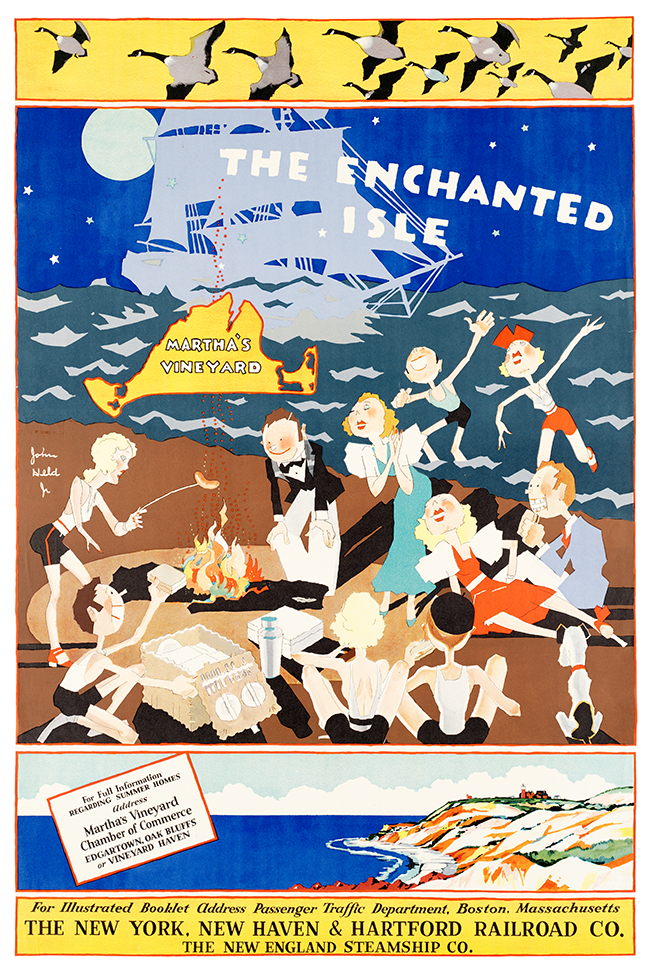
The New York, New Haven & Hartford Railroad dominated rail travel between Boston and New York from the 1890s to the end of World War II. A company with over 2,000 miles of track and 120,000 employees, it also owned electric trolley companies and steamboat lines, including the Fall River Line. In 1910, the railroad bought the New Bedford, Martha’s Vineyard, and Nantucket Steamboat Company–sole provider of ferry service to the Islands–and turned it into a subsidiary under the name New England Steamship Lines.
The absorption of the boat line enabled New York, New Haven, and Hartford to offer seamless travel from New York City, Connecticut, and Rhode Island to the Vineyard. Travelers could board a train at Pennsylvania Station in Manhattan and check their bags directly to the pier at Vineyard Haven, Oak Bluffs, or (until the early 1930s) Edgartown. It also set the stage for elaborate advertising campaigns that presented the Vineyard as a playground of the rich and stylish.
This poster, one of a series produced by the railroad to advertise New England destinations, presents the 1930s version of that fantasy. Artist John Held Jr. fills it with examples of carefree young women “flappers” and their straw-hatted college-student paramours–two cultural icons he helped to create.

5. Islander revolutionized ferry service to the Vineyard
Title: Islander
Reference: RU 359
The first ferry designed and built for the newly established New Bedford, Woods Hole, Martha’s Vineyard, and Nantucket Steamship Authority (SSA), the motor vessel Islander entered service in 1950. For the next 57 years, it operated almost exclusively on the 6-mile route between Woods Hole and Vineyard Haven, making multiple round trips a day with up to 48 cars and nearly 800 passengers on each one.
The Islander was the first Island ferry to be powered by diesel rather than steam, and the second (after the aging Hudson River train ferry Hackensack, which the SSA operated as a stopgap in 1947-1949) to use a “roll-on/roll-off” design with doors at each end. This configuration, which allowed Islander to carry tractor-trailer trucks, revolutionized the transportation of consumer goods to the Island. It streamlined the supply chain for Island merchants, but placed Island cranberry growers and dairy farmers in direct competition with mainland companies like Ocean Spray and H. P. Hood, all but forcing them out of business. An ugly duckling when viewed alongside the graceful steamers of the 1920s (like the Nobska), the Islander became a sentimental favorite of Island residents and visitors. Whenever the SSA announces plans to build a new ferry, a chorus of “give us another Islander” rises in response.
6. Summer “excursion boats” carried day tourists to Oak Bluffs
Title: The Island Commuter
Date: 1968
Reference: RU 131
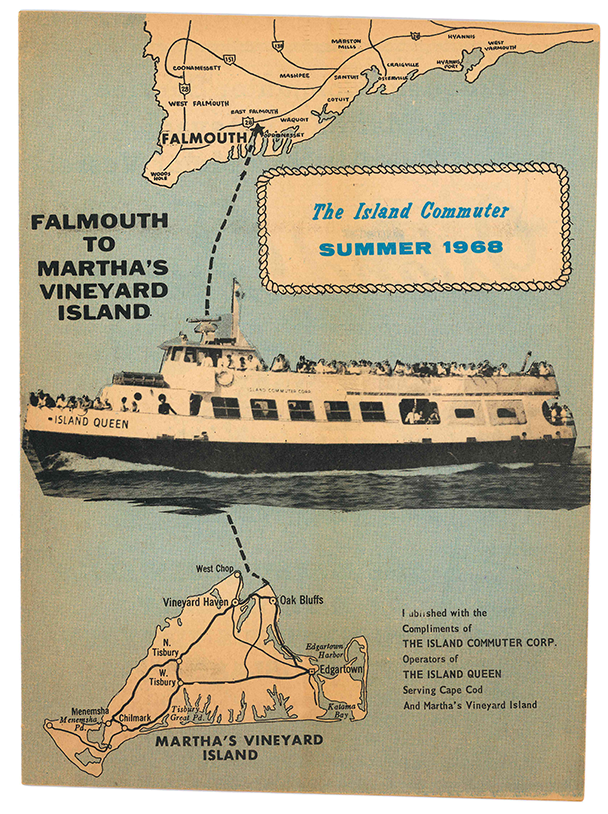
The Steamship Authority was created in 1946 to guarantee reliable passenger, vehicle, and freight service to Martha’s Vineyard and Nantucket. The legislation that created the SSA granted it a monopoly on vehicle and freight transportation, in order to ensure that it would make a sufficient profit during the high-traffic summer months to cover its inevitable operating deficits in the low-traffic winter months.
The legislation, however, gave the SSA the option of licensing seasonal, scheduled ferry services that would carry only passengers and their personal baggage, not vehicles or heavy freight. This option created a business opportunity for vessels collectively known as “excursion boats,” like the Kateri-Tek, the Nautican, and the Island Commuter Corporation’s Island Queen. Despite the company name, it (like the other excursion-boat operators) overwhelmingly served day-tripping tourists rather than commuters.
The company’s first vessel, the Vineyard Queen, began operations from Falmouth to Oak Bluffs in the early 1960s, docking along the newly installed bulkhead at the head of Oak Bluffs Harbor. It was replaced, after a few years, by the first Island Queen, shown here. The current Island Queen entered service in 1974, making it the longest-serving excursion boat on the Vineyard run.
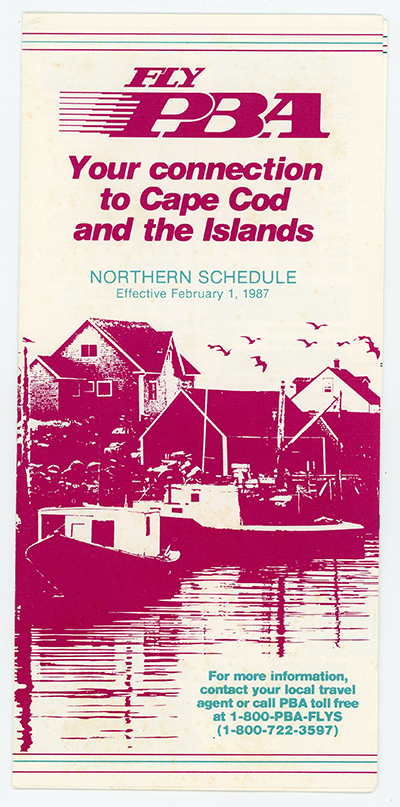
7. Provincetown-Boston Airline was the Island’s leading air carrier for 40 years
Title: Provincetown-Boston Airlines Timetable
Date: 1987
Reference: RU 633
Founded by John C. Van Arsdale in 1949, Provincetown-Boston Airlines (PBA) provided scheduled air service to the Cape and Islands from Logan Airport in Boston and LaGuardia Airport in New York. It also operated routes in Florida, flying to destinations throughout the state from bases in Miami, Tampa, and Jacksonville.
On the Vineyard, PBA flew into the Martha’s Vineyard Regional Airport, which had been built as a US Navy Auxiliary Airfield in 1942 and turned over to Dukes County for civilian use in 1946. Even in a late-1930s-vintage DC-3 (a mainstay of the PBA fleet from 1968 until 1988), a flight from Martha’s Vineyard to Boston took less time than a ferry ride to Woods Hole. Like the Old Colony Railroad service from Boston to Woods Hole (discontinued in 1964), it offered a carefree (if not always smooth) ride, uninterrupted by traffic jams, detours, and road construction.
Its reputation damaged by two crashes in the fall of 1984, PBA filed for bankruptcy and merged with a succession of larger carriers, eventually disappearing into the Continental (now United) Airlines system. The last PBA-branded flights to the Vineyard took place in 1988, not long after this schedule was published.
8. Islander passes her successor Island Home in Vineyard Haven Harbor
Title: Islander and Island Home –Historic Passing
Artist: Denys Wortman
Date: 2007
Reference: 2018.026.001
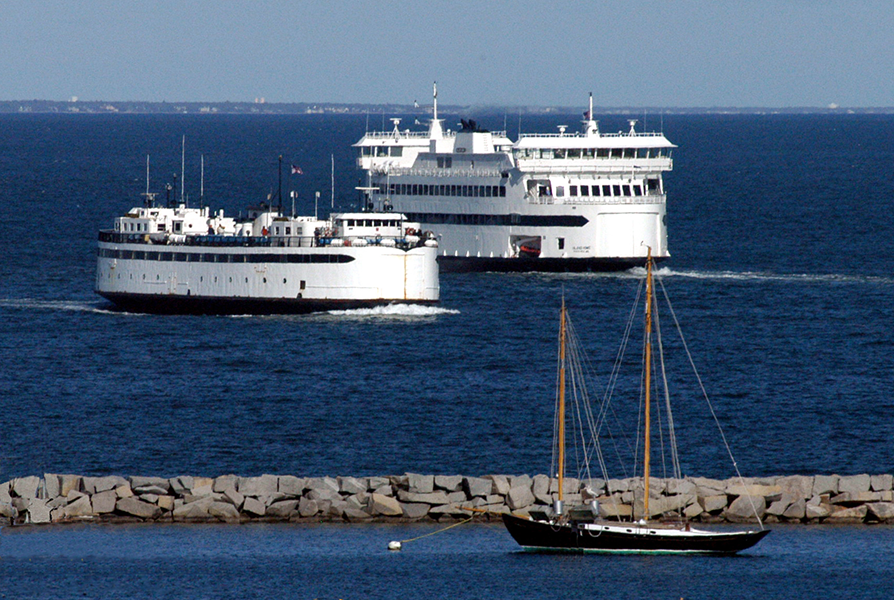
The Steamship Authority began planning a replacement for the beloved but aging Islander in 1997. The original design, modeled on the proven Nantucket (1974) and Martha’s Vineyard (1992), was shelved after Vineyard residents insisted on a “true double-ender” that (like Islander) would never have to back into or out of its slip.
The Island Home, which entered service in 2007, was an Islander adapted to the demands of the modern world. It shared the slab-sided, blunt-bowed look of the Islander and, like its predecessor, had a pilothouse at each end of the upper deck. It was 25% longer and a deck taller, however, with 50% more capacity for passengers and automobiles. The three central lanes of its five-lane freight deck could accommodate tractor-trailer trucks or–in the case of the outer central lanes–a second layer of cars parked on hydraulically operated “lift decks” lowered from the ceiling. It was also several knots faster, its shorter crossings compensating for longer turn-around times in port.
The Island Home entered SSA service in March 2007 and, on one of the last runs of her 57-year career, passed her successor outside the Vineyard Haven Harbor breakwater. Photographer Denys Wortman captured the moment from the rooftop observation deck of the Mansion House hotel.
